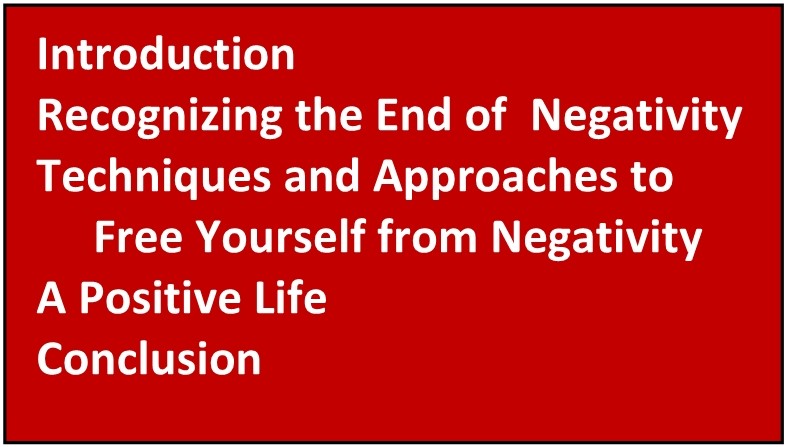Techniques for Freeing Yourself From Negativity, Part (I)
INTRODUCTION
Freeing yourself from negativity: freeing is an accurate word in that we can feel caught and powerless in the grip of negativity. However, as we understand how we create our negativity we can feel empowered to eliminate it. Freeing yourself from negativity is a quest, a process, a “work in progress.” Something that takes a while but generates benefits along the way.
How do you know that you have too much negativity? You can consult the list of effects of negativity contained in the October 2019 Letter. (See endnote[i].) If you are experiencing many of the affects you have too much negativity. We said that negativity is an overly negative approach towards life and is caused by excessively negative beliefs, attitudes, thoughts, feelings, and expectations. The process of freeing yourself from negativity is a process of change that starts with identifying the beliefs that cause the attitudes, thoughts, feelings, and expectations that generate negativity. Getting stuck in negativity is a vicious circle that perpetuates itself and reinforces negativity. A negative belief gives rise to a painful experience that reinforces the negative belief. (“You see I told you so. I knew that I was right to think this way.”)
(We are talking about the importance of your beliefs. You can find a full exploration of beliefs in the March to July 2018 Letters, see index[ii]. The May 2018 Letter[iii] describes how to discover what your beliefs are. The June 2018 Letter[iv] explains how to generate new beliefs and how to change beliefs.)
There is no quick fix to ending negativity but the sustained effort to eliminate negativity generates immediate rewards in reducing the amount of destructiveness in your life. Also, you immediately open yourself to more positive experiences. Since there is no quick fix, some of the approaches to ending negativity can be complicated. But working with them is life changing, changing in “small, medium, and large” ways.
Practice: Tune into your pleasure and pain as clues to the positive and negative in your life. Consider the question, “Am I experiencing too much pain and therefore too much negativity?” Begin the quest to end negativity.
RECOGNIZING THE END OF NEGATIVITY
What does freeing yourself from negativity look like? How do you know that you have made progress in freeing yourself? You feel better, are happier and more optimistic, and experience more joy and fulfillment. Your relationships improve and you experience fewer of the effects of negativity.
Point Of Empowerment: We are not looking for perfection, but to be free enough to be able to recognize negativity when you slip into it and to pull yourself out by using these techniques.
TECHNIQUES AND APPROACHES TO FREE YOURSELF FROM NEGATIVITY
Here are some specific techniques and approaches for ending your negativity. This first technique is the most straightforward and may be the easiest to implement. Other approaches are a bit more complex and therefore take more concentration, effort, and commitment to use. Pick one or two to put into practice.
- Draw a line down the middle of a piece of paper. On the left side write down negative thoughts as they arise. On the right side translate that negative thought into a positive thought. When you become aware of the negative thought say, “No, I prefer this thought,” then think the positive thought. This creates a potential shift in your outlook and can train your brain to generate more positive thinking. Some examples are:
| Negative Thought | Positive Thought |
| Since if feel unhappy I won’t have a good day. | How I feel now can change in an instant. If I expect a good day I will have one. |
| My mother constantly disapproves of me. | Sometimes my mother disapproves of me but sometimes the unhappy look on her face has nothing to do with me. |
| I can’t show people how happy I am, they will be jealous. I can’t stand their jealousy. | If someone is jealous of my happiness, it is not my problem. Their jealousy can’t hurt me. It is just unpleasant. |
Discovering a positive thought for the chart can be challenging. Just write down whatever positive thoughts you can think of until you come to the one that will work the best.
- In the face of negativity, shift your attention by focusing on something pleasurable. We are completely in control of what we focus our attention on. When you are feeling discomfort or pain you can shift you attention to something positive and pleasurable. We are not saying to deny the existence of pain, discomfort, or displeasure. These feelings contain important information for us and need to be faced squarely, with attention, and with the intention of addressing the causes of these feelings. We are talking about the unnecessary, hurtful negativity that we can be stuck in and that haunts us. For example:
“I felt insulted by my spouse’s assumption that I was not going to get something that she needed and asked for. After feeling the hurt I refocused my attention by remembering the favor my spouse did for me by buying me something that I needed.”
- Become aware of negative thoughts and release them by stating this affirmation, “I now move this thought out of my mind.” Imagine it leaving in whatever way you can think of. Replace it with a positive thought and experience the positive feeling that is generated. The positive feeling encourages us to continue doing this exercise. A classic visualization is imagining a thought sitting on a cloud within the “sky of your mind.” Imagine this cloud drifting out of sight. Repeat this exercise with a specific thought as often as necessary to feel confident that it is gone.
- Examine what you learned from your parents about the positive and negative in life. What did they say and what did they teach you by the example of their behavior? See how this is encoded in beliefs. Reject any overly negative beliefs that you discover. Substitute more positive beliefs and more constructive behavior for the beliefs and behavior you discovered.
- My mother told me that life would be hard and that a person can’t get a break. New belief: Life is both hard and easy. Life frequently provides opportunities that could be thought of as “breaks.” Look for those opportunities.
- My father always struggled with money. I guess making money will always be a struggle. New belief: If I focus on having fun while I make money, making money will be pleasurable.
- My parents hardly touched each other and slept in separate bedrooms. I guess this is what marriage looks like, little love and affection. New belief: My parents’ marriage does not belong to me. I am free to learn how to have a good marriage and therefore to create the marriage I want.
- My parents fought frequently. I fight with my spouse because I think that this is what married people do. New belief: Conflict is a normal part of marriage but we can settle conflicts in a spirit of cooperation and love.
- My mother often made me feel guilty. I hold onto this guilt thinking that it makes for a good conscience. New belief: I can have a healthy conscience that guides me with wisdom about what is right and wrong.
- My father was very critical of my older brother and occasionally beat him up. I have become very self-critical and live in fear. I now direct my father’s negativity toward myself. New behavior: I stop my self-criticism and build the self-confidence that I need to live without fear.
- Identify negative attitudes, thoughts, feelings, and expectations. Ask yourself, “What are the beliefs that give rise to these attitudes, thoughts, feelings, and expectations.” Change the belief.
- At times I have a chip of hostility on my shoulder. I believe that there are people “out there” who are just waiting to attack you. My hostility protects me.
- I continually think that “I am not good looking enough (or pretty enough) to be attractive to the opposite sex,” (or to someone of the same sex if that is your orientation.) My core belief that “I am not good enough” influences how I think about myself in many specific situations.
- I feel anxious or depressed often. My belief that I am not good enough causes me to feel this way.
- My expectation is that I will fail. This causes me to avoid many things that I would like to try. I believe that I am generally incompetent and therefore have little confidence in myself.
- Notice your negativity at a specific moment in time. We could call this a “glass half empty” moment. In the Glass Half Full/Glass Half Empty Letter[v] we identified a sequence that starts with noticing that there is something missing in a “half empty” moment. See if you can discover what positive aspect of life is missing at that moment and bring it into your life. Enjoy the good feeling that is generated.
- On a late fall day you notice that leaves are missing from trees that have dropped their leaves. You feel sad and stop there. Now notice that a few of the trees look pretty because they still have some of their leaves and that some bare trees have a certain elegance to them.
- “I had a difficult day with my child because he/she was very uncooperative. I feel frustrated and angry.” Instead of stopping there, also remember that there were moments of cooperation and fun and feel good about that.
A POSITIVE LIFE
Creating a positive experience of life is partly about what you consistently focus your attention on. Focus on the positive/pleasurable aspects that exist in any moment of time. Experience the good feelings that follow. This will change your mood. Focus on:
- The light and warmth of the sun
- The intricate texture of the clouds
- The beauty that completely surrounds us
- Children at play
- People feeling happy and enjoying themselves
- The taste of good food
- The heroic struggle of human beings
- Wonder, goodness, and love
- The Divine
Expand this list by adding the things that make you feel good. The number of possibilities is almost endless. We are not saying that one should deny the “negative” as the negative is part of life. But whenever possible, after noticing the negative focus on a positive aspect of what you have noticed.
Point Of Empowerment: Remember, we are totally in control of what we focus our attention on.
CONCLUSION
As you work to free yourself of negativity you are improving the inner “climate” that you live in, the underlying mood that is always with you. You are removing the pollution of negativity and giving yourself a climate with fresh air and new possibilities. We will continue to explore additional approaches to end negativity in the next Letter.
A thought for the holiday season that is in line with what we have been discussing. Create an enjoyable holiday season by doing many things that bring you happiness and joy. Say “no” to expectations that cause you stress.
Point Of Empowerment: In the now moment the world is as it is and cannot be different, whether you are in a good mood or a bad mood. Which mood do you prefer?
[i] October 2019 Effects of Negativity https://iifsd.org/library/newsletters/october-2019-letter/
[ii] Letter Index https://iifsd.org/library/newsletters/
[iii] May 2018 Identify Beliefs https://iifsd.org/library/newsletters/may-2018-letter/
[iv] June 2018 Changing Beliefs https://iifsd.org/library/newsletters/june-2018-letter/
[v] August 2019 Glass Half Full/Half Empty https://iifsd.org/library/newsletters/august-2019-letter/
